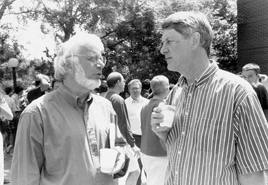1998: Mechanisms of Transcription, Vol. LXIII
Organizer: Bruce Stillman
The field of gene transcription is intertwined with many other areas of modern biological research because of its fundamental significance. It has been some time since a Cold Spring Harbor Laboratory Symposium focused solely on this important topic, in part because transcription is usually included in all Symposia in one form or another. But because of the significant advances that have occurred over the last few years in our understanding of how genes are transcribed, it seemed appropriate to hold a meeting on this topic again. The dramatic advances made in this field during past 20 years have led to the identification of a vast set of basal transcription factors in eukaryotes. Moreover, this field has encompassed the exciting progress in related areas such as structural biology and chromatin structure and function.
Nearly 40 years have passed since the discovery of the first RNA polymerase by Sam Weiss, an event noted in a later page of this volume. Today we are in the midst of a very stimulating era that is focused on understanding the mechanisms of gene transcription, and, at this Symposium, we listened to 67 talks that reflected this excitement.
Many previous Cold Spring Harbor Laboratory Symposia have incorporated aspects of gene transcription and gene regulation into the program, as this topic in many ways represents the core of biology. Most noteworthy was the famous 1977 Symposium on Chromatin, where the fundamental understanding of gene structure in eukaryotes was overturned.
It was also most fitting that a Symposium on gene transcription be held this year as we celebrated the 30th year that Jim Watson has worked at the Laboratory, first as Director for 25 years and now as President. At the beginning of this meeting, I presented to Jim, on behalf of the Laboratory, a gold model of the DNA double helix. Five years ago, Jim presented the twin of this golden helix to Francis Crick at a Cold Spring Harbor meeting on the occasion of the 40th anniversary of their discovery of the structure of DNA. What better time to make this presentation to Jim than when many of his former students and colleagues were present? Prior to his coming to Cold Spring Harbor, Jim's laboratory at Harvard had made some of the key contributions to the early work on the mechanisms of gene transcription, including the discovery of ? factor.
Jim noted in his foreword to the Symposium volume of that year: "The final result was a compromise between a desire to hear everyone with relevant data and the need to restrict the talks to a number ingestible within a week's time." In this respect, nothing has changed in the last 28 years. It was necessary to make the usual hard choices in selecting speakers. For the organization of this meeting, my colleagues Winship Herr, Nouria Hernandez, Bob Tjian, Carol Gross, Rich Losick, and a number of others provided valuable advice.
One of the many responsibilities of the Director is to organize the annual Symposium, and this Jim did for many years. The first Symposium he organized, in 1970, was appropriately enough on "Transcription of Genetic Material." It celebrated, among other things, the discovery 2 years before of the ? factor for RNA polymerase in bacteria. At this meeting, David Baltimore also presented the exciting news of reverse transcriptase.
The Symposium started with a fascinating first night of introductory talks from Carol Gross, Robert Tjian, Tom Maniatis, and David Allis. Bob Roeder, who
| 
has made many seminal contributions to the biochemistry of transcription, presented this year's Reginald Harris Lecture. The formal scientific program consisted of 67 oral presentations and a record 155 poster presentations, and the meeting attracted 437 participants. I thank Rich Losick for agreeing to summarize the meeting and writing such a marvelous and thoughtful paper, matching the great summaries of previous Symposia.
We were particularly fortunate this year to have Lewis Miller as an artist in residence during the meeting. Lewis, who hails form Melbourne, Australia, won the prestigious Archibald Portrait Prize in 1998. While here, he sketched many of the Symposium participants, and Blackford Hall is now graced with some of these marvelous portraits.
Essential funds to run this meeting were obtained from the National Cancer Institute, a branch of the National Institutes of Health. In addition, financial help from the Corporate Sponsors of our meetings program is essential for these Symposia to remain a success and we are most grateful for their continued support. The following are the 1998 Symposium sponsors:
Corporate Sponsors: Amgen Inc.; BASF Bioresearch Corporation; Bayer Corporation; Bristol-Myers Squibb Company; Chiron Corporation; Chugai Research Institute for Molecular Medicine, Inc.; Diagnostic Products Corporation; Forest Laboratories, Inc.; Genentech, Inc.; Genetics Institute; Hoechst Marion Roussel; Hoffmann-La Roche Inc.; Johnson & Johnson; Kyowa Hakko Kogyo Co., Ltd.; Eli Lilly and Company; Merck Genome Research Institute; Novartis Pharma Research; Novo Nordisk Biotech, Inc./ZymoGenetics, Inc.; OSI Pharmaceuticals, Inc.; Pall Corporation; Parke-Davis Pharmaceutical Research; The Perkin-Elmer Corporation, Applied Biosystems Division; Pfizer Inc.; Pharmacia & Upjohn, Inc.; Research Genetics, Inc.; Schering-Plough Corporation; SmithKline Beecham Pharmaceuticals; Wyeth-Ayerst Research; Zeneca Group PLC. Plant Corporate Associates: American Cyanamid Company; Monsanto Company; Pioneer Hi-Bred International, Inc.; Westvaco Corporation. Foundation Associates: Albert B. Sabin Vaccine Institute at Georgetown University. Corporate Contributors: Genome Systems; Lexicon Genetics; Qiagen, Inc.
I thank Diane Tighe, Mary Smith, and Nancy Weeks in our meetings and courses office, and Herb Parsons and his audiovisual staff, under the talented direction of David Stewart, for their efficient organization of this meeting. Wendy Crowley efficiently handled the various grant applications. The organization of this meeting would not have occurred without great help from my assistant Delia King. It was again a pleasure to work with the Laboratory Press, under the direction of John Inglis, particularly Joan Ebert and Dorothy Brown.
— Peter Sherwood |